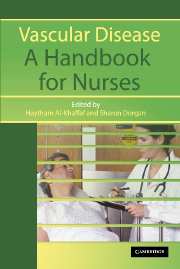4 - Management of Vascular Patients on the Ward
Published online by Cambridge University Press: 12 August 2009
Summary
NURSING CARE OF PATIENTS WITH PERIPHERAL VASCULAR DISEASE
INTRODUCTION
Caring for the patient with peripheral vascular disease (PVD) poses a challenge for nurses, as these patients do not always present with PVD in isolation. Many patients also suffer from diabetes and cardiac conditions. Partial or complete occlusion of a vessel results in reduced blood flow, causing oedema and congestion within the tissues (Watson & Royal, 1987). Pain experienced by vascular patients can be unrelenting and difficult to control.
Patients presenting with PVD need a thorough assessment of their needs and subsequent care provided by nurses with an understanding of vascular disease. This chapter addresses some of the problems encountered by patients with PVD and outlines the nursing care required for certain procedures and operations.
ACUTE AND CRITICAL LIMB ISCHAEMIA
A sudden onset of severe pain as a result of an occlusion of an artery or vein will result in the patient requiring immediate treatment.
On admission the patient should be urgently assessed by medical staff.
Patients may be admitted from a variety of settings, to include the outpatients clinic, by general practitioner (GP) referral, accident and emergency department, from home or a specialist unit, such as renal or diabetes clinics.
Nursing care
The aim of nursing care is to establish a baseline for further recordings.
Rationale
The rationale includes the following:
Assessment of the affected limb, including skin colour, temperature, presence or absence of pulses, and pain.
[…]
- Type
- Chapter
- Information
- Vascular DiseaseA Handbook for Nurses, pp. 121 - 148Publisher: Cambridge University PressPrint publication year: 2005



